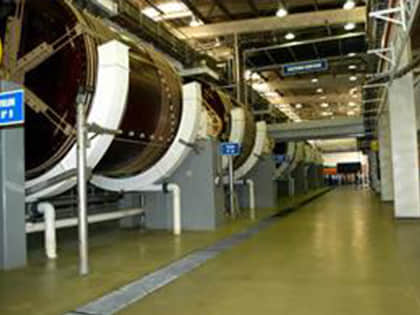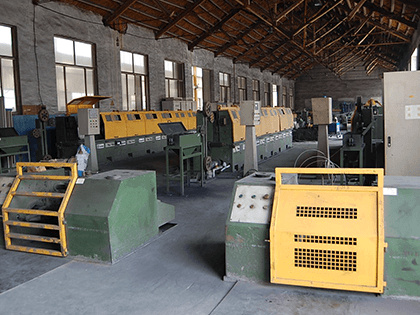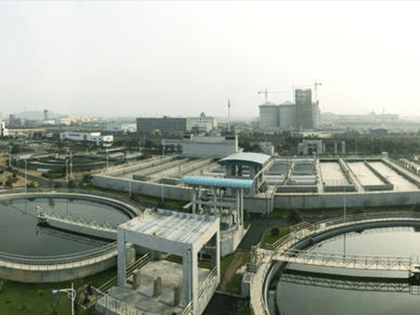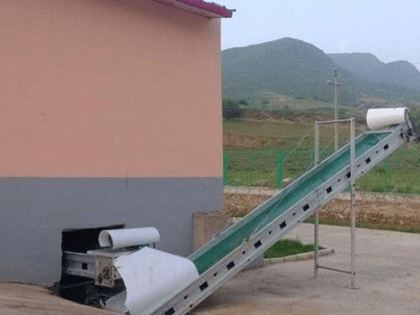Environmental pollution and control in the process of sludge dehydration
Author: Taida machine Release time:2016-08-20
Reading guidance:Sludge drying is the use of heat to dry sludge drying, sludge 1/4-1/5, granular or powder, the volume is only the original, and because the water content below 10%, microbial activity was completely in
Sludge drying is the use of heat to dry sludge drying, sludge 1/4-1/5, granular or powder, the volume is only the original, and because the water content below 10%, microbial activity was completely inhibited, to avoid the product because of microorganisms and musty smell, is conducive to the storage and transportation of hot dry heat sterilization. The process is completely, the sludge thermal drying performance improving, products are widely used, can be used as alternative energy sources, but also land use. The sludge to dry sludge reduction, stabilization, harmless, resource. Because of the sludge drying dehydration gradually revealed removal of sludge water advantages, can effectively solve the key problems encountered in the disposal of sludge treatment, application of drying technology has been paid more and more attention and gradually become a major means of sludge treatment. But the sludge drying process will have a certain amount of environmental pollution, it will What are the environmental risks should be how to control it?
1. Environmental risk in the process of sludge dehydration
Sewage treatment process and the sludge treatment process will be a volatile gas pollution, especially malodorous gases, mainly consist of sulfide (H2S, methyl mercaptan, methyl sulfide), (such as ammonia, dimethylamine) nitride, carbon, hydrogen or carbon, hydrogen, oxygen compounds (alcohols, aldehydes, fatty acids), these substances in very low concentration still caused great social and environmental issues, is one of the world recognized seven sludge (air pollution, water sludge, sludge soil, noise, vibration, land subsidence, foul). Sludge treatment process (toning, enrichment and mechanical dehydration, etc.) the sewage treatment process (sink, biochemical treatment, etc.) at the beginning of the odor smell of value is much higher, the mud filtrate and heat treatment to release a quantity to the other sludge treatment steps of sludge odor high & although sludge drying can effectively in preparation for the subsequent resource utilization, and from the current technical and economic analysis of its application in the sludge drying is feasible, but the drying process of the risk of the environment may be volatile out large amounts of pollutants, causing secondary sludge, it has become the sludge drying technology must face and solve the technical problem in the promoted application, also caused the attention of many scholars.For pollution control of the sludge mainly in two aspects: one is the process control, makes every effort to minimize the sludge drying process from the source of pollution elements volatilize quantity;The second is dry tail gas purification treatment.
2. Tail gas pollution caused in the process o sludge dehydration
Sludge drying, moisture removal at the same time, inevitably make sludge in some volatile and unstable substances decomposed into dry tail gas. Dry tail gas composition generally comprises a carrier gas! Steam! Dust and gaseous pollutants. The gaseous pollutants mainly include:
A. Gaseous pollutants such as boiler flue gas is used as the direct drying heat source, so the sulfur dioxide and nitrogen oxides in the flue gas will be used in the dry tail gas.
B. Sludge volatiles and decomposition & sludge drying, ammonia, hydrogen sulfide, benzene, aldehyde and lipid has a low boiling point and vapor pressure higher pollutants with the evaporation of water into the exhaust gas, and also some easy breakdown products in sewage sludge to dry tail gas, such as ammonium bicarbonate is decomposed into ammonia;Heating time is too long, sludge drying sludge after excessive temperature rising, volatiles and decomposition to continue a lot into the tail gas, such as ammonia, hydrogen sulfide and water, carbon monoxide and other inorganic and hydrocarbon grey, methanol, acetaldehyde and other organic matter.
C. Sludge volatile or decomposition may react with carrier gas composition, generate secondary product mix in tail gas, or direct contact with the sludge in the carrier gas pollutants, and react with some ingredients in the sludge, fixed in the carrier gas pollutants, reduce exhaust pollutants concentration for drying.
3. Pollution control in the process of sludge dehydration
Sludge drying can effectively achieve the volume reduction, but drying process of all kinds of pollutants. If there is no corresponding treatment measures, will cause secondary pollution, how to effectively control the sludge drying process of pollutants release and effective purification of exhaust gas, sludge drying technical safety and wide promotion and use of key issues must be resolved by.
Researchers with calcium oxide as absorbing agent in the inhibition of sludge release of hydrogen sulfide, ammonia and other odor, found that compared with pure sludge drying, adding 10 wt % of CaO sludge, in a certain temperature, the release of hydrogen sulfide and ammonia in the sludge quantity reduced 94% and 86.1% respectively;Adding CaO, also found that the sludge volatile composition most reduced by 77.8%, compared with pure sludge drying, the drying rate can be increased by 19.6%, studies have shown that drying temperature determines the intensity of the sludge ammonia release, it can be finished at low temperature by controlling the sludge drying process of inhibiting the release of the sludge of ammonia strength, through multistage wet dust removal in addition to gas, can remove most of the release of the sludge drying ammonia and other harmful gases such as hydrogen sulfide, and almost can remove all the smoke.Moreover andrez development of a new generation of closed, with returns of direct heating drum drying system, using the gas cycle reuse design reduces the exhaust emissions and processing cost, and bring pollution of stench gas was sent to a biological filter processing, to meet the requirements of environmental protection in order to achieve discharge standard.Has developed more than indirect via condensation, drying process exhaust after wash back to the furnace, will produce odor compounds completely decomposed, tail gas can meet the very strict emission standards.
In a word, sludge drying technology is a long-term profitable investment, compared to other disposal methods.
1. Environmental risk in the process of sludge dehydration
Sewage treatment process and the sludge treatment process will be a volatile gas pollution, especially malodorous gases, mainly consist of sulfide (H2S, methyl mercaptan, methyl sulfide), (such as ammonia, dimethylamine) nitride, carbon, hydrogen or carbon, hydrogen, oxygen compounds (alcohols, aldehydes, fatty acids), these substances in very low concentration still caused great social and environmental issues, is one of the world recognized seven sludge (air pollution, water sludge, sludge soil, noise, vibration, land subsidence, foul). Sludge treatment process (toning, enrichment and mechanical dehydration, etc.) the sewage treatment process (sink, biochemical treatment, etc.) at the beginning of the odor smell of value is much higher, the mud filtrate and heat treatment to release a quantity to the other sludge treatment steps of sludge odor high & although sludge drying can effectively in preparation for the subsequent resource utilization, and from the current technical and economic analysis of its application in the sludge drying is feasible, but the drying process of the risk of the environment may be volatile out large amounts of pollutants, causing secondary sludge, it has become the sludge drying technology must face and solve the technical problem in the promoted application, also caused the attention of many scholars.For pollution control of the sludge mainly in two aspects: one is the process control, makes every effort to minimize the sludge drying process from the source of pollution elements volatilize quantity;The second is dry tail gas purification treatment.
2. Tail gas pollution caused in the process o sludge dehydration
Sludge drying, moisture removal at the same time, inevitably make sludge in some volatile and unstable substances decomposed into dry tail gas. Dry tail gas composition generally comprises a carrier gas! Steam! Dust and gaseous pollutants. The gaseous pollutants mainly include:
A. Gaseous pollutants such as boiler flue gas is used as the direct drying heat source, so the sulfur dioxide and nitrogen oxides in the flue gas will be used in the dry tail gas.
B. Sludge volatiles and decomposition & sludge drying, ammonia, hydrogen sulfide, benzene, aldehyde and lipid has a low boiling point and vapor pressure higher pollutants with the evaporation of water into the exhaust gas, and also some easy breakdown products in sewage sludge to dry tail gas, such as ammonium bicarbonate is decomposed into ammonia;Heating time is too long, sludge drying sludge after excessive temperature rising, volatiles and decomposition to continue a lot into the tail gas, such as ammonia, hydrogen sulfide and water, carbon monoxide and other inorganic and hydrocarbon grey, methanol, acetaldehyde and other organic matter.
C. Sludge volatile or decomposition may react with carrier gas composition, generate secondary product mix in tail gas, or direct contact with the sludge in the carrier gas pollutants, and react with some ingredients in the sludge, fixed in the carrier gas pollutants, reduce exhaust pollutants concentration for drying.
3. Pollution control in the process of sludge dehydration
Sludge drying can effectively achieve the volume reduction, but drying process of all kinds of pollutants. If there is no corresponding treatment measures, will cause secondary pollution, how to effectively control the sludge drying process of pollutants release and effective purification of exhaust gas, sludge drying technical safety and wide promotion and use of key issues must be resolved by.
Researchers with calcium oxide as absorbing agent in the inhibition of sludge release of hydrogen sulfide, ammonia and other odor, found that compared with pure sludge drying, adding 10 wt % of CaO sludge, in a certain temperature, the release of hydrogen sulfide and ammonia in the sludge quantity reduced 94% and 86.1% respectively;Adding CaO, also found that the sludge volatile composition most reduced by 77.8%, compared with pure sludge drying, the drying rate can be increased by 19.6%, studies have shown that drying temperature determines the intensity of the sludge ammonia release, it can be finished at low temperature by controlling the sludge drying process of inhibiting the release of the sludge of ammonia strength, through multistage wet dust removal in addition to gas, can remove most of the release of the sludge drying ammonia and other harmful gases such as hydrogen sulfide, and almost can remove all the smoke.Moreover andrez development of a new generation of closed, with returns of direct heating drum drying system, using the gas cycle reuse design reduces the exhaust emissions and processing cost, and bring pollution of stench gas was sent to a biological filter processing, to meet the requirements of environmental protection in order to achieve discharge standard.Has developed more than indirect via condensation, drying process exhaust after wash back to the furnace, will produce odor compounds completely decomposed, tail gas can meet the very strict emission standards.
In a word, sludge drying technology is a long-term profitable investment, compared to other disposal methods.
:Discussion of best running condition for sludge dehydration incineration :Use daily sludge to make light ceramic particles
Relevant news
- 2016-01-12OSC-II Model Sludge Dryer Deliv
- 2016-01-1215T/Day Aerobic Dynamic Ferment
- 2016-01-12Matters Should Be Paid Attentio
- 2016-01-12Methods exploration of chemical
- 2016-01-12Analysis of circulating fluid b
Industry trends
- 2016-01-12Comparison Between Different Sl
- 2016-01-12Adding Calcium and Stable Dispo
- 2016-01-12Sludge Treatment: Methods for S
- 2016-01-12Use Dyeing Sludge As Resource
- 2016-01-12Current situation of sludge dis
Hot spots
Hot-sale products

- Leather Industry Sludge Drying
Production Capacity:1-2200t/h

- Welding Plating Sludge Drying S
Production Capacity:1-2200t/h

- Municipal Sludge Drying Solutio
Production Capacity:1-2200t/h

- Manure Sludge Drying Solution
Production Capacity:1-2200t/h
 中文
中文 English
English Home
Home
